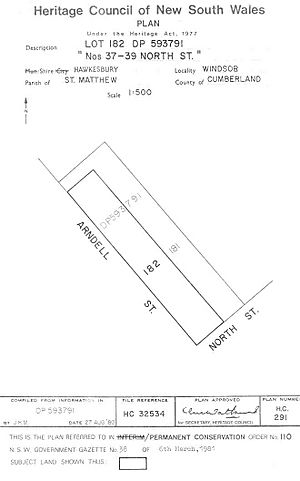Court House Hotel, Windsor facts for kids
Quick facts for kids Court House Hotel |
|
|---|---|

Heritage boundaries
|
|
| Location | 37-39 North Street, Windsor, City of Hawkesbury, New South Wales, Australia |
| Official name: Houses; two-storey sandstock bricks building; Peninsula Hotel; Court House Hotel; former inn | |
| Type | State heritage (built) |
| Designated | 2 April 1999 |
| Reference no. | 110 |
| Type | House |
| Category | Residential buildings (private) |
| Lua error in Module:Location_map at line 420: attempt to index field 'wikibase' (a nil value). | |
The Court House Hotel is a very old building in Windsor, Australia. It used to be a hotel but is now a home. It's special because it's listed on the New South Wales State Heritage Register. This means it's an important part of history. It's often linked to other old houses nearby on North Street.
Contents
History of the Area
Aboriginal History
Long ago, the land around the Hawkesbury River was home to the Dharug people. The river, which they called Deerubbin, was very important for food and travel. The Darkinjung people also lived in this area. It was a great place to find food.
Early European Settlement
In 1789, Governor Arthur Phillip explored this area. He was looking for good land for farming. He found and named the Hawkesbury River. European settlers started living here by 1794. This region was very important for the early colony. It was known for its rich farmland. The area, first called Green Hills, helped feed the colony. But the river often flooded, which was tough for farmers.
In 1794, Samuel Wilcox was given 30 acres of land here. He called it Wilcox Farm. Later, this farm became part of a bigger area called Peninsula Farm.
Governor Macquarie's Influence
Governor Lachlan Macquarie became governor in 1810. He helped the colony grow a lot. He built many public buildings and improved roads. Under his leadership, the Hawkesbury district became very successful.
In 1810, Governor Macquarie visited the area. He named the new towns. He called the town in Green Hills "Windsor". He named the town in the Richmond district "Richmond". These towns, along with Castlereagh, Pitt Town, and Wilberforce, are known as Macquarie's Five Towns. They were named after towns and leaders in England. These towns, especially Windsor and Richmond, became more permanent with streets and public buildings.
History of the Court House Hotel Building
Building the Hotel
In the 1840s, the land where the Court House Hotel stands was part of Peninsula Farm. This farm was divided into smaller lots. One of these lots, Allotment 18, was bought by John Shearing in 1842. He also bought the nearby properties at 35 and 31-33 North Street.
John Shearing built the current Court House Hotel building between 1842 and 1846. Many people believe it was first built or used as the Peninsula Hotel. In 1846, Shearing sold the property to Uriah Moses.
A Hotel Near the Court House
Between 1846 and 1848, the building got a license to be a hotel. It was named the Court House Hotel because it was close to the Windsor Court House.
In 1861, Thomas Chaseling bought the property. He used it as his family home for a while. In 1867, James Reardon held a hotel license for the building. In the 1870s, it might have become a hotel again. Robert Leddra ran it as the Court House Hotel in 1877. In the 1880s, the building was even used as a private school!
Later Years and Restoration
In the early 1900s, the building was reportedly divided into two homes. In 1922, Thomas Chaseling left the properties to Thomasina Smith. Later, in 1945, Thomasina Smith left the properties to her five daughters. They sold them to Thelma Mullinger, and the Mullinger family owned them for many years.
In 1974, John Fisher bought the properties. A month later, he sold them to the National Trust of Australia (NSW). The National Trust is a group that protects important old places. In 1976, they officially recognized the building as important. They did a lot of repairs and made the two separate homes into one big house again.
The building even appeared on TV! It was used as the doctor's office in the show A Country Practice. Later, the old hotel building was sold back to private owners.
What the Building Looks Like
The Court House Hotel at 37-39 North Street is a two-storey building. It's made from special old bricks called sandstock bricks. It has sandstone around the windows and doors (called lintels and sills). The verandah floor is also made of sandstone. There's even a cellar under the house! It also has some smaller buildings outside.
The front of this building, like other old houses on North Street, is close to the street. There's a narrow grassy path in front. All these old properties have big trees behind them and nice gardens around the houses.
Experts have looked at the ground around the building. They think there might be old things buried there. These could be from other buildings, yards, or even old rubbish from the mid-1800s.
Heritage Listing
The Court House Hotel was added to the New South Wales State Heritage Register on 2 April 1999. This means it's officially recognized as a very important historical place in New South Wales.

